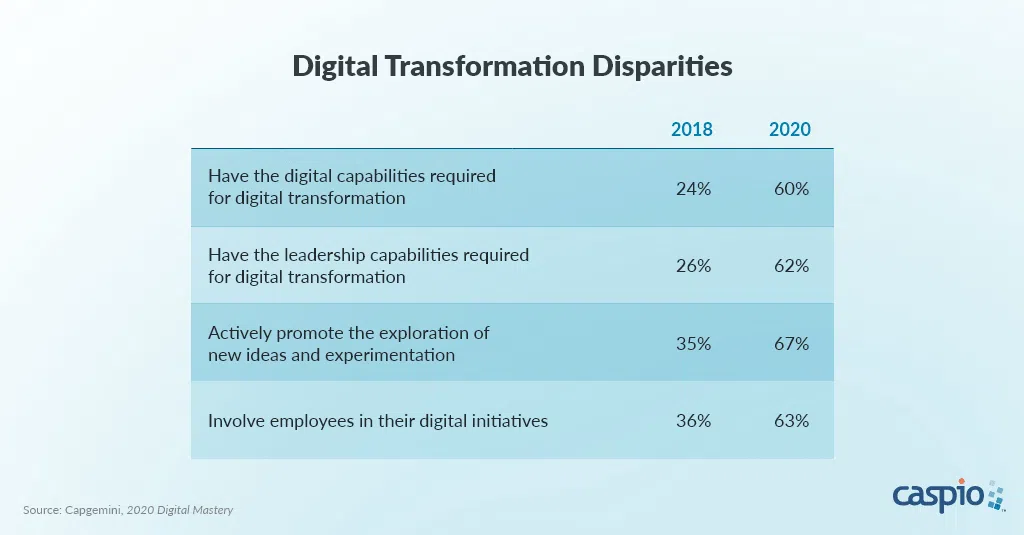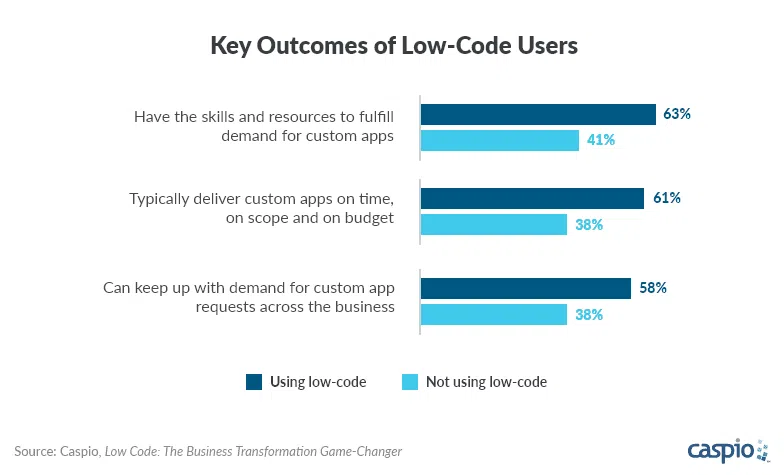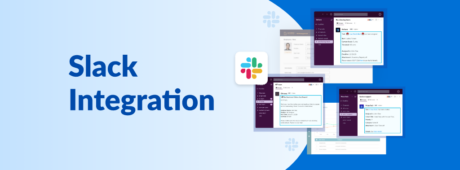How Low-Code Development Fast-Tracks Digital Transformation During the Pandemic
March 18, 2021

Before COVID-19, only 24% of organizations said they had the capabilities to digitally transform. But as companies faced greater urgency due to the pandemic, that number skyrocketed to 60%.
In the midst of it all, low-code development is helping the world move forward, one application at a time.
Using Low Code to Innovate in the New Normal
Companies turn to innovation to survive crises. The adoption of video conferencing and teleworking tools and the use of 3D printers to manufacture respiratory ventilators for COVID-19 patients are only some examples.
With the pandemic as a catalyst, low-code app development is helping businesses address the needs of their virtual workforce and stay-at-home customers by revolutionizing application development.
Low code empowers business professionals to build custom cloud applications using visual, point-and-click tools instead of hand-coding. This means anyone in the organization can create applications that they urgently need.
During the early days of the pandemic, many organizations leveraged low-code development to innovate and quickly build timely solutions.
As Ohio started seeing a significant rise in transmissions last year, media company Cleveland.com built a COVID-19 tracker that shows a county-by-county breakdown of new cases reported each day.
When the government announced a stimulus package, California news website The Fresno Bee created an interactive online calculator that helped families estimate how much relief they may receive.
In both cases, it was low code that helped these organizations quickly create solutions that would have otherwise taken considerable time and resources to build using traditional software development.
Combining People and Low-Code Technology
According to Gartner, “digital transformation can only succeed when employees are digitally dexterous.” Good thing organizations are heading in the right direction.
Research by Capgemini shows that as much as 63% of companies today involve their employees in their digital transformation efforts, compared with just 36% last year. However, involving employees in digital transformation initiatives — especially in software development — is easier said than done.

Traditional software development requires a team of hard-to-find, highly technical personnel, including developers, quality analysts, DevOps specialists and more. Businesses have neither the budgets nor the patience to hire all this talent.
In Caspio’s Low Code: The Business Transformation Game-Changer report, we found that the main hurdles in custom app development are budgets and IT talent.
That’s why there’s a strong case for low-code development.
“Either you significantly up level the digital literacy of employees by teaching them how to code, how to be programmers, or you drastically simplify and reduce the complexity of development,” said Caspio VP of Global Marketing Brian Metzger in a report by CIO Dive.
The Caspio platform actually offers a free database solution that empowers businesses to build, customize and launch simple apps for unlimited users. It’s simply the best introduction to the low-code revolution.
Accelerating Digital Transformation With Low-Code Development

By combining low-code development and employee involvement, businesses accelerate digital transformation amid the COVID-19 pandemic. Here are a few ways how.
Cut End-to-End Development Time
Speed is the most significant advantage of low-code development. With this approach, business professionals create new applications in hours or days instead of weeks or months. A simple web app takes 10 minutes to make.
SiteRocket Labs, a Boston-based custom software development agency, built a series of HIPAA-compliant applications for their healthcare clients using Caspio’s low-code platform. With low code, they reduced end-to-end application development time by over 60%.
“Every project is different, but Caspio cuts that process down to a fraction of the time,” SiteRocket Labs founder David Emerson said.
Empower Anyone to Build Cloud Apps
Unlike traditional development, which requires technical skills and elaborate IT infrastructure, low-code development relies on drag-and-drop and point-and-click tools. This allows business professionals to build apps primarily by clicking, not coding. Low code empowers the person closest to the problem to solve it without relying on backlogged and short-staffed IT teams.
Kim Graff, director of customer experience and support at home telematics startup Roost, struggled with unifying and managing disparate company data. She described the experience as “death by spreadsheets.” Using Caspio, Graff built a secure online database that pulled data from multiple sources — and she did it without any programming experience.
“Caspio is a tool for business people,” she said.
Create Apps to Address Unique Requirements
It’s impossible to digitally transform without addressing the “longtail” or the processes and systems that are unique to your business. Think internal workflows, data reporting, custom CRM and other proprietary solutions. It’s the “secret sauce” that differentiates your business from competitors.
Low code accelerates the development of longtail applications by empowering the business professionals who know these unique processes like the back of their hand.
Low-code platforms provide extensive customizability and even integration with existing cloud services your team already uses. All this is done without programming. But if needed, tech-savvy users have the option to inject code to further tailor-fit the application. Remember, the app must adapt to your business, not the other way around.
Seeds of Hope, a nonprofit organization helping children gain access to education, once struggled to support their unique needs-based scholarship model because they couldn’t modify their cookie-cutter software. Using Caspio’s low-code platform, they built a custom tuition right-sizing app that allowed them to quickly calculate grants and send more kids to school.
“Before, we were using a solution we couldn’t customize and would frequently break. And now with Caspio, I’m empowered to customize my solutions,” shared Gina Wilson, director of allocations and partnerships.
Support IT Teams to Scale and Adapt
Low-code platforms also accelerate digital transformation by supporting the team at the forefront of it all — the IT department.
Instead of starting from scratch with every new project, IT personnel can customize existing application interfaces and expedite the deployment of reports, forms, charts and other digital tools. This allows IT to clear project backlogs faster.
The inherent scalability of low-code platforms also allows IT teams to react to business demands in real-time, including spikes in application usage and development projects. “Infrastructure departments are going to love that. It’s all hosted externally,” said Paul Woolsey, applications manager at national oil and gas business J-W Power Company.
Even amid an industry recession, divestitures and workforce adjustments, Woolsey and his team built over 30 digital transformation tools using Caspio.
“Don’t dilly-dally. This stuff is fast!”
Join the Low-Code Leader
By empowering business professionals to participate in the app-building process, organizations move closer to their digital transformation goals — faster.
Caspio is ranked a low-code leader by Forrester, earning the highest score in the “Current Offering” category, which reviews application development and management tools of platforms on the market. “Caspio, a pioneer, has quietly built the richest platform for business developers” with “no glaring holes in its product,” Forrester said.
Want to fast-track app development in your organization today? Try the world’s leading low-code development platform.
Schedule a free consultation with one of our specialists today to see how you can fast-track digital transformation within your own business using Caspio.
















